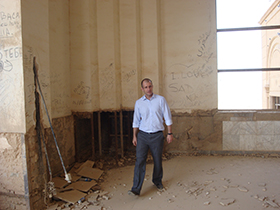Deakin researcher named as one of US’ real monument men and women
Media releaseIt might be the stuff of Hollywood movies but for Deakin University's own Monument Men and Women Dr Ben Isakhan and Di Siebrandt, working to protect the country's cultural heritage in the thick of a war zone and post war Iraq is very real.
Ms Siebrandt, an archaeologist, has just been named by the US' Combatant Command Cultural Heritage Action Group (CCHAG) as one of its real monument men and women for her work with Iraqis to preserve Iraq's archaeological resources for future generations.
From 2006 until early 2013, Ms Siebrandt worked as the State Department's Cultural Heritage Liaison Officer at the U.S. Embassy in Baghdad, Iraq.
She is currently putting her experiences in the country, and with the Department of Justice's Iraq Mass Grave Project to use as part of her PhD thesis looking at the relationship dynamics that existed between US/coalition military troops and Iraqi archaeologists during all phases of the Iraq War, and what effect those relations had on protecting archaeological sites.
Her work is part of a larger Australia Research Council (ARC) project headed by Dr Isakhan looking at the relationship between heritage destruction and violence in Iraq since 2003.
The project is expected to generate new understandings of the complex inter-relationship that exists between the destruction of cultural heritage and sharp upsurges in terror and violence.
Ms Siebrandt was brought into work in Iraq during the Iraq war to assist in establishing dialogue between US government personnel and Iraqi heritage experts. Issues such as widespread looting and damage to Iraqi heritage sites was foremost on the list of needed 'fixes."
"There were huge mistakes made on many levels, but mostly they were made because of lack of communication between the US military, the State Department, the Americans in Iraq and the Iraqis," she said.
Ms Siebrandt updated the training the troops received but also worked with Iraqi conservators, the Iraqi Ministry of Culture and State Board of Antiquities and Heritage, the US military and State Departments as well as UNESCO and universities to establish a conservation centre to train Iraqi museum professionals.
She also helped procure State Department funding for the World Monuments Fund to develop a sustainable management plan for the site of ancient Babylon.
Ms Siebrandt also joined U.S. military experts and Iraqi archaeologists to document ongoing threats to the Assyrian imperial capital of Ashur and accompanied many American and other foreign archaeologists on surveys to document the looting of Iraqi sites.
"I have always loved Iraq and its role in the birth of civilisations fascinates me," she said,
"Being able to walk in the footsteps of where great kings once ruled and where the wheel, astronomy and the written law code were all invented is exhilarating to say the least.
"Iraq's unique and important history, everything their ancients gave us to form modern western civilization, is well worth saving.
"Every culture is proud of their own heritage, the Iraqis are no difference, and ultimately, we all share their history."
Ms Siebrandt said her time embedded with the US troops was an incredible experience
"If you can protect heritage sites you can save lives," she said.
"We were working in an area in the southern part of Baghdad, where the museum and curator's premises had been looted.
"I started working with the military to protect the site and the curator was thrilled to be able to come back, he saw the military there as keeping the site safe.
"The only reason I stopped doing it was because the US withdrew its troops from Iraq and we handed the reins back to the Iraqis.
"I am hoping that one day I can get back to the region and continue working to help people in conflict and post conflict zones."
Dr Isakhan said The Monuments Men came at an interesting time, particularly given that conflict in much of the Middle East has seen heritage sites destroyed on an industrial scale.
"The Monuments Men is the story about a group of men during World War II who were concerned about the plight of monuments, cultural property and heritage objects and their efforts to protect it from damage as well as massive theft and smuggling," Dr Isakhan said.
"They set up The Monuments Men and lobbied their governments on behalf of cultural property.
"The fact that these guys would take this on and make a name for themselves by being determined to protect it, means we have paintings in the Louvre and other galleries and many historic buildings still stand in Europe.
"If the film makes us feel a need to protect museums, libraries and other archaeological sites which are important not just historically but also to the people who live there then that is a good thing."
Dr Isakhan said he realised the enormity of what he was asking.
"I realise how significant this is and how incredibly difficult it is for the military in a conflict and post conflict zone when you have got bullets flying around and people demanding water, food and safety," he said.
"It is difficult to put cultural heritage at the centre of what you do and start protecting stones rather than detonating mortars.
"The early findings from our research show that the failure to protect cultural heritage does in fact cost lives.
"When you fail to protect heritage sites it antagonises the local people who see the protection of the sites as your responsibility and they quickly become offside.
"They pick up guns and start shooting back and it exacerbates the conflict."
Share this story
 Dr Ben Isakhan inspects some of the damage done to a heritage site in Iraq.
Dr Ben Isakhan inspects some of the damage done to a heritage site in Iraq.
